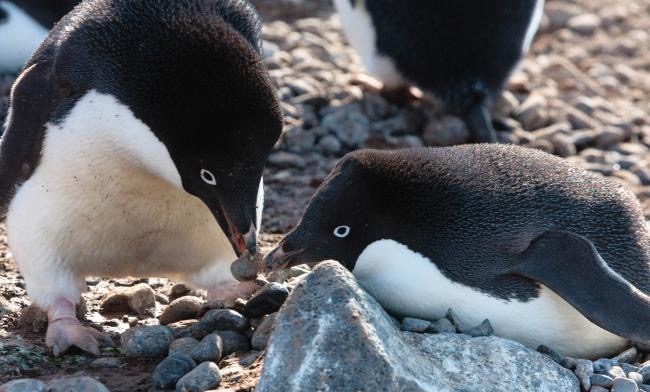By Sophia Byl
The universe is out to get you and every other living thing on this planet–breaking news or not, it’s true. Nature isn’t pretty, and the continent of Antarctica is the epitome of that idea. Bitingly cold with winds travelling at 100 miles per hour? Sounds like a rather unpleasant vacation spot (or Canada), but as always, some pioneering species manage to call the barren ice desert home.
Today we turn a natural spotlight onto the feisty Adélie penguin, one of 7 penguin species living on Antarctica. As the continent’s only flightless birds, the penguins of Antarctica have turned to the water as their means of survival. Adopting the sea as their domain meant that penguins were introduced to a slew of adaptations to help them manage a life that was both frigid and aquatic. Like most Antarctic penguins, the Adélie creates stone nests on land and feeds in the sea, their prey of choice being jellyfish and crustaceans. They also have special salt glands that prevent the concentration of sodium in their bodies from getting dangerously high–an adaptation not seen in freshwater life, but essential for a saltwater lifestyle.
However, in the size department, Adélies are outclassed. Dwarfed by the likes of emperor and king penguins, this would otherwise make them vulnerable to predators in the sea (such as seals) and sky (such as gulls), who would take advantage of the penguin’s light weight. Luckily, nature has given Adélie penguins a perfect and occasionally humorous solution to this daunting problem–an attitude.
The Adélie penguin is not afraid to stand its ground against predators twice or three times its size. This assertive behavior can be seen in defensive situations, like when the penguin needs to defend its life against a leopard seal, or offensively, in the case of trying to steal resources from other Adélie penguins. They have even been known to come after human visitors to the Antarctic. One explorer by the name of Apsley Cherry-Garrard described the penguins “furiously beating his shins with his flippers” in his memoir The Worst Journey in the World. On the personality of the Adélies, he wrote, “Whatever a penguin does has individuality, and he lays bare his whole life for all to see… fighting always with the most gallant pluck, he comes to be considered as something apart from the ordinary bird.” How poetic.
Along with a feisty temperament, Adélies have been seen exhibiting a strong sense of justice. In nature, selflessness of this type is referred to as altruism, and it’s often very interesting to see in action. Natural selection requires most organisms to be selfish to survive, competing to make sure their genes stay in the gene pool. The idea that the polar opposite of this might be beneficial instead is a question that many researchers have posed, in terms of both evolutionary biology and animal cognition–do the animals recognize their actions as altruistic? Do the selfless organisms gain any tangible advantage by helping out, since whether or not they experience emotional satisfaction is still being debated? Altruism can ultimately be selfish, in the case of individuals who only help others for recognition and validation. However, the altruism of the Adélie penguin dodges this categorization by going not only cross-generational, but cross-species.
One of the ways penguins have learned to stay warm is to huddle together and share their body heat. This can be observed in lots of different organisms, including humans, but in subzero climates like Antarctica it’s a matter of life and death. Therefore, the Adélies pack close together for warmth–but what about the ones on the outside of the amorphous penguin blob? They aren’t surrounded on all sides like some of their friends, and are thus benefiting less from the huddle as a whole. The altruistic solution? Taking turns, of course. Adélies too recognize the valuable lesson that sharing is caring, and by rotating themselves and coordinating their movements they ensure that each penguin gets a chance in the central, warmest part of the huddle.
Huddle altruism pales in comparison, however, to another bold behavior of the Adélie penguins that converges the interspecies line. When face-to-face with a predator, their fight-or-flight response is activated–and penguins are flightless birds. They are apt at defending themselves, but they also frequently come to the rescue of other penguins, namely emperor penguin chicks. As highlighted in the spectacular 2005 documentary March of the Penguins, young emperor penguins make a dangerous trek across Antarctica to the breeding grounds every year. The incredible journey is made so tough by harsh weather conditions, the difficulty of finding food, and birds of prey.
Birds like petrels are too small to take on an adult emperor, but the emperor chicks make perfect snacks. So to protect its fellow tuxedoed friends from certain doom, the Adélie draws itself up to its full 2.5 feet height and spreads its flippers. This is enough to drive most predatory birds away (they’ve almost certainly tussled with Adélies in the past and are well aware of the consequences), and the triumphant Adélie chaperones the juvenile emperors along on their journey.
It’s not quite clear what Adélie penguins gain from helping the emperors. The two species are barely related besides sharing a taxonomic order and habitat. Perhaps it is just true altruism–proof that there are good-hearted penguins out there helping their brothers in flippers.

